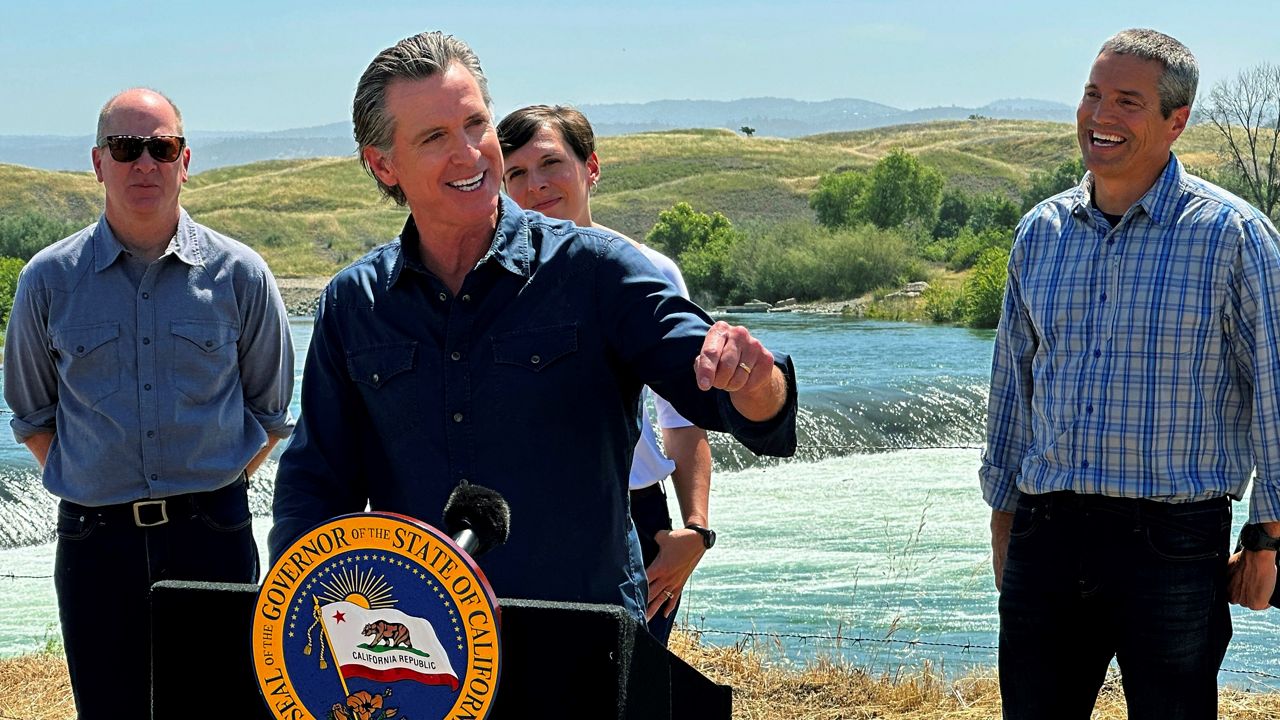MARYSVILLE, Calif. (AP) — California officials on Tuesday said they will spend about $60 million to build a channel along the Yuba River so that salmon and other threatened fish species can get around a Gold Rush-era dam that for more than a century has cut off their migration along the chilly waters of Sierra Nevada streams.
The project is the latest example of state and federal officials trying to reverse the environmental harms caused by the century-old infrastructure along California's major rivers and streams. Those dams and canals allowed the state to grow into the economic powerhouse it is today. But they have devastated natural ecosystems that have pushed salmon — a species once so abundant it sustained Native American populations — to the edge of extinction.
Last year, federal regulators approved the largest river restoration project in U.S. history that will remove four dams along the Klamath River near the Oregon-California border. State and federal officials have plans to remove other dams that impede fish migration, including the Matilija Dam in Ventura County and the Rindge Dam in Los Angeles County.
Tuesday's announcement will affect the Daguerre Point Dam near the Northern California city of Marysville. The federal government first built the dam in 1906 as a way to stop the seemingly endless flow of debris left over from hydraulic mining during the height of the Gold Rush of the mid 1800s.
The dam is mostly underwater, allowing the water to spill over the top of it while holding back a mountain of sediment. But it also blocks three species of fish from migrating up the river to spawn — spring-run Chinook salmon, steelhead trout and green sturgeon.
The National Marine Fisheries Service declared in 2012 that the dam posed a threat to the survival of those fish species. Coming up with a solution has been difficult as the dam has been mired in controversy for nearly 50 years about who is responsible for its maintenance and management.
“Within a few decades, Gold Rush mining created impacts that have lasted over 150 years. We’re finally taking action to reverse those impacts,” Willie Whittlesey, general manager of the Yuba Water Agency, said Tuesday during a news conference attended by Gov. Gavin Newsom and other state, local and federal officials.
The three fish species are born in the cold, freshwater rivers filled with snowmelt from the Sierra Nevada. Once they hatch and grow big enough, they migrate through the river delta to the Pacific Ocean. They then return to the rivers, swimming upstream to where they were born to lay more eggs.
Dams stop the fish from reaching their spawning grounds. It's a big reason why populations have plummeted, along with droughts and diversions that reduce the flow of water in rivers while increasing the temperature of the water. Commercial salmon fishing was closed along much of the West Coast earlier this year because of low fish populations.
Aaron Zettler-Mann, interim executive director and science director for the South Yuba River Citizens League, said he is excited about the idea of large amounts of fish finally being able to bypass the dam. But he said it's still not the best solution for the species.
He said fish naturally swim upstream and aren't looking for side channels to bypass dams. Plus, he said the river has lots of gravel in it that will eventually clog the channel, making it difficult for fish to use it without regular maintenance.
Instead, he said the best option would be to remove the dam entirely, something he says at least two studies from the federal government have pointed to within the past 20 years.
“I think that if those people stood there together and said, ‘Hey, we want to pull this dam out,’ they probably could have gotten the political will to make it happen,” he said.
Whittlesey said the dam still has its uses, including making it easier to divert water from the Yuba River for nearby farms.
Chuck Bonham, director of the California Department of Fish and Wildlife, said the channel will mimic the natural flow of the river before it was dammed. Once opened, he said it will give fish another 12 miles of habitat.
Officials plan to install new screens to keep the fish from getting into the other canals that send water to irrigate agriculture. And they are planning to study taking spring-run Chinook salmon above New Bullards Bar Dam further north along the Yuba River.
“Not all dams should be removed. Most of our infrastructure is essential, and it still serves a useful purpose,” Bonham said. “So you get creative.”
Scott Artis, executive director of the Golden State Salmon Association, said non-governmental organizations working along the Yuba River were not included in the planning of this channel.
“Thus, it’s hard to comment, as we simply have not seen the terms of the deal,” he said. “In principle, we support both passage around Daguerre Point Dam and reintroduction to the upper Yuba. But the details matter.”
The project will cost $60 million, with $30 million coming from the state and the rest coming from the Yuba Water Agency. Gov. Gavin Newsom said keeping the funding in the budget is a priority for him despite the state facing a nearly $32 billion budget deficit this year.
“Despite a modest deficit, we’re holding the line on these projects,” Newsom said Tuesday. “These are tangible. You can see the fruits of your tax dollars.”



